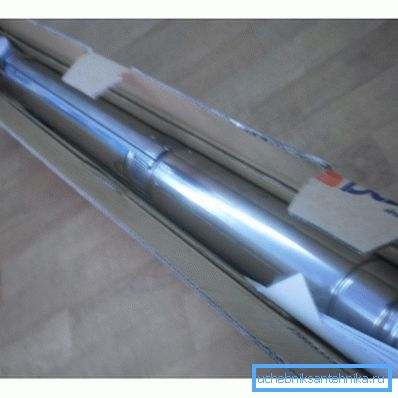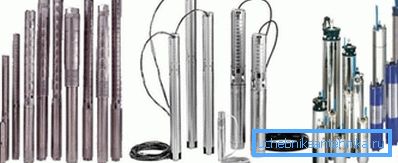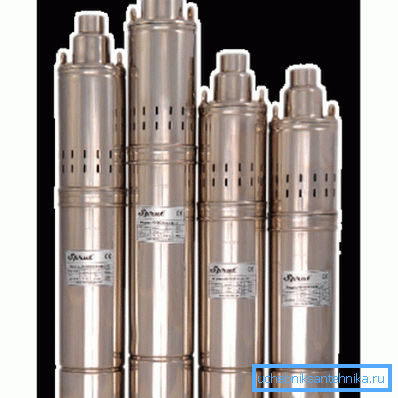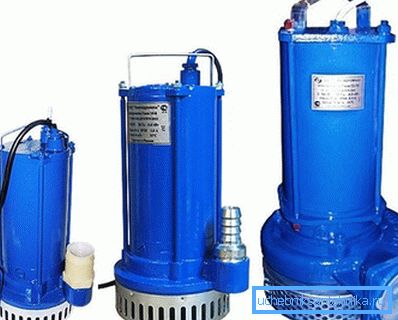Submersible pump for a well of 30 meters or more:
Practically all units of this type can be divided into two main groups used for dirty or clean water, although there are still many subspecies. So, in order to understand the difference between, for example, a pump for a well 10 meters from an instrument that is used for a well of the same depth, we will pay attention to the classification by purpose. All of this, as well as the installation, we will discuss below, and also look at the thematic video in this article as additional material.

About submersible pumps
Purpose

- The implementation of the water intake from water sources of this type can be carried out as a surface (hydrophore) and submersible unit for pumping water. But the pump for the well at 15 meters will already be of the submersible type, since the hydrophores are effective only up to the 9m depth (meaning the level of water rise). Such devices have an elongated cylindrical shape with a small cross-section, so that they are easier to place in the production pipe, and have a cable attached to the body for fixing on the surface.
- Such units, as a rule, are centrifugal and are designed exclusively for pure water (without large impurities such as sand or silt). This pump for a well of 80 meters or even 200-250m can perfectly meet the needs of not only domestic, but also of industrial nature. In order to avoid interruptions in water supply, the capacity of the unit is selected according to the amount of water consumed and you can see such calculations for the house in the table below.
| Bathroom name | Water flow |
| Washbasin taps | 0.4m3/hour |
| Bidet | 0.4m3/hour |
| Toilet | 0.4m3/hour |
| Sink taps | 0.7m3/hour |
| Dishwasher | 0.7m3/hour |
| Washing machine | 0.7m3/hour |
| Shower cabin | 0.7m3/hour |
| Hydrant for watering the garden (garden) | 0.7m3/hour |
| Bath | 1.1m3/hour |
Water consumption for an hour in different bathrooms
- Externally, the centrifugal unit is similar to a vortex pump for a well of 40 meters or more, only the water supply is carried out in a slightly different way. Such devices are used when you need to create a strong pressure with a small amount of water, for example, for washing any objects, as they are 3-7 times more powerful. The main disadvantage of such an acquisition is that when even a small amount of abrasive substances, such as sand, are injected, the pump quickly fails.

- Such units are very good to use in those situations when the water intake is made with abrasive substances, for example, when cleaning wells. But this is not at all necessary, because the final purification of water can be done at the top, therefore, such devices are quite suitable for supplying for food needs. For example, Chinese auger
Sprut 4S QGD 1.2-50-0.37 is made of stainless steel, it pumps up to a height of 93 m in a volume of 33 l / min, and its price is only 100 cu
- Unlike wells, for water intake from wells, you can use submersible pumps such as the Kid, which have a vibratory pumping system, which means they do not need maintenance so much, which increases their service life. But such devices are used with a small distance of the water mirror from the ground surface, but they must be sunk to a depth of at least a meter - this allows you to protect yourself from level fluctuations inherent in the wells.

- For pumping dirty water from different tanks, wells, reservoirs and the like, drainage units are used, which easily pass through abrasives and other debris. In accordance with the purpose of the device choose the device impeller. Thus, the multichannel wheel serves to pump liquid with abrasives, sludge or small debris, single-channel - for larger solid elements, including feces and open - for pumping liquid with debris from 30 to 70 mm, such as household waste, fallen leaves and other garbage.
Note. Among the drainage units there are special pumps designed for pumping from faeces. The difference is that there is a special shredder that can recycle not only long-fiber waste, but also household waste such as gloves, towels, and so on.
Assembly work

So, we will assume that you have determined with the capacity of a submersible pump, that is, you have chosen the one that will provide uninterrupted water intake taking into account the static and dynamic level (flow rate) of the well. Now we need to solve the problem with a branch line, it can be made in the form of a caisson (pit at the production pipe) or adapter.
You also need to immediately determine the location of the backup tank, sensors and automation - they can be either in the house or some of the outbuildings, where they can be located both on the surface and in a specially equipped pit.

Most developers, designing a house, plan a place for a well directly in the building, which is quite convenient for further installation and operation of water supply. However, the principle of installing a water intake system remains the same, and the same rules are followed everywhere.
Now let's look at the depth of the dive, but for this you need to know what the dynamic level of the column in the production pipe is - these indicators are usually given by the drillers, or you calculate them yourself. So, the pump casing, or rather, its upper part should disappear to a meter depth, especially for wells in the sand, where the level may depend on seasonal precipitation (30–40 cm is enough for an artesian, since a constant level is maintained there).

Regardless of the depth of the well, the electrical cable to connect the pump will still be short, so it will have to be spliced. To do this, on the tip often provide a special terminal box for 4 inputs-output, as in the photo above, so that you can connect, as a three-phase and single-phase motor.
However, in most cases, the masters prefer joints on stranding, when a heat shrinkable sleeve is put on each of the cores, as well as the cable as a whole, which completely blocks the ingress of moisture on the copper, which means excludes oxidation.
From the submersible pump to the distribution unit, a polyethylene hose with a diameter of 32 mm is unambiguously used, and the rest of the wiring is made by polypropylene for soldering, but in some cases, metal-based laminate is used.
The reserve water tank can be of different sizes, but it should be borne in mind that by increasing the tank capacity, you reduce the number of starts and stops of the engine, which significantly extends its service life. For domestic use, the capacity of more than 100 liters you do not need.
Note. To further reduce the number of starts and stops, you can adjust your own time relay. Thus, the factory settings are designed to stop the pump when a pressure of 3 atmospheres is set, and it is started when the pressure drops to 2 atmospheres. But you can reduce this gap by setting, respectively, 5 and 1.5 atmospheres.
Conclusion
In any case, each submersible pump has an instruction from the manufacturer on its installation and operation, which must be observed. But it should also be noted that a large role in the high-quality operation of the unit is played by downhole filters and care of the source, which must be cleaned at least once every 3-5 years. You will already choose the cleaning method yourself, but it will depend on the size and device of the well.